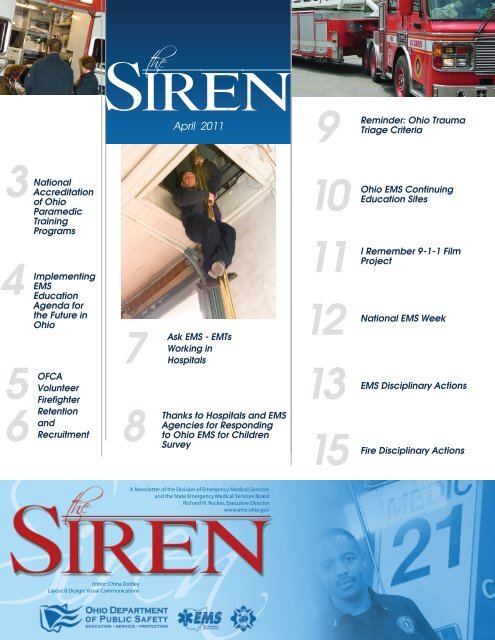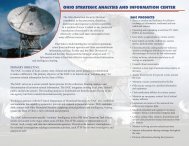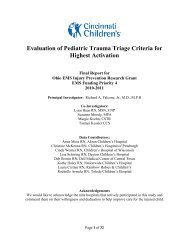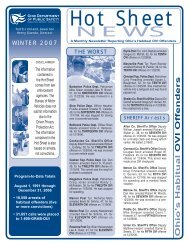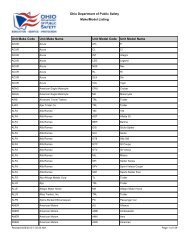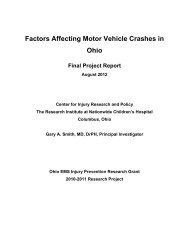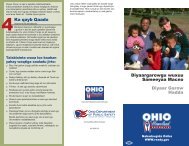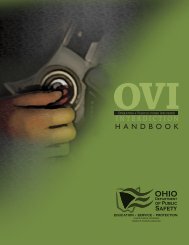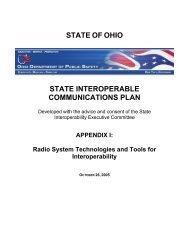Beyond Lights And Sirens - Ohio Department of Public Safety
Beyond Lights And Sirens - Ohio Department of Public Safety
Beyond Lights And Sirens - Ohio Department of Public Safety
Create successful ePaper yourself
Turn your PDF publications into a flip-book with our unique Google optimized e-Paper software.
3<br />
4<br />
5<br />
6<br />
National<br />
Accreditation<br />
<strong>of</strong> <strong>Ohio</strong><br />
Paramedic<br />
Training<br />
Programs<br />
Implementing<br />
EMS<br />
Education<br />
Agenda for<br />
the Future in<br />
<strong>Ohio</strong><br />
OFCA<br />
Volunteer<br />
Firefighter<br />
Retention<br />
and<br />
Recruitment<br />
Editor: China Dodley<br />
Layout & Design: Visual Communications<br />
Siren<br />
th e<br />
April 2011<br />
7<br />
8<br />
Ask EMS - EMTs<br />
Working in<br />
Hospitals<br />
Thanks to Hospitals and EMS<br />
Agencies for Responding<br />
to <strong>Ohio</strong> EMS for Children<br />
Survey<br />
A Newsletter <strong>of</strong> the Division <strong>of</strong> Emergency Medical Services<br />
and the State Emergency Medical Services Board<br />
Richard N. Rucker, Executive Director<br />
www.ems.ohio.gov<br />
9<br />
10<br />
11<br />
12<br />
13<br />
15 Fire<br />
Reminder: <strong>Ohio</strong> Trauma<br />
Triage Criteria<br />
<strong>Ohio</strong> EMS Continuing<br />
Education Sites<br />
I Remember 9-1-1 Film<br />
Project<br />
National EMS Week<br />
EMS Disciplinary Actions<br />
Disciplinary Actions
<strong>Beyond</strong> <strong>Lights</strong> and <strong>Sirens</strong>:<br />
By Division <strong>of</strong> EMS Executive Director Richard Rucker<br />
The Division <strong>of</strong> Emergency Medical<br />
Services under went a reassessment<br />
<strong>of</strong> <strong>Ohio</strong>’s EMS system by a Technical<br />
Assistance Team (TAT) <strong>of</strong> experts from<br />
the National Highway Traffi c <strong>Safety</strong><br />
Administration. The assessment took<br />
place on February 15 -17, 2011 at Deer<br />
Creek State Park in conjunction with<br />
the State EMS Board Planning Retreat.<br />
The TAT revisited the ten essential<br />
components <strong>of</strong> an optimal EMS<br />
system that were used in the <strong>Ohio</strong>: An<br />
Assessment <strong>of</strong> Emergency Medical<br />
Services, in 2001. These components<br />
provided a quality assurance report<br />
based on ten standards. While<br />
examining each component, the TAT<br />
identifi ed key EMS issues, reviewed<br />
the State’s progress since the original<br />
report, assessed its status, and used the<br />
eleven 2009 reassessment standards<br />
as the basis for recommendations for<br />
<strong>Ohio</strong> EMS system improvement.<br />
The TAT reported that there were<br />
notable gaps in the system, however;<br />
they stated that a great deal has been<br />
accomplished that has provided a<br />
foundation for future improvements.<br />
The TAT <strong>of</strong>fered a number <strong>of</strong><br />
recommendations to the Division and<br />
Board to assist in the improvement <strong>of</strong><br />
the EMS System in <strong>Ohio</strong>. The Board<br />
and Division, will be working with<br />
the Strategic Planning committee to<br />
encompass a large portion <strong>of</strong> the TAT<br />
recommendations into the fi ve year<br />
Strategic Plan.<br />
The eleven reassessment standards reviewed<br />
1. Regulation and Policy<br />
2. Resource Management<br />
3. Human Resources and Education<br />
4. Transportation<br />
5. Facilities<br />
6. Communications<br />
7. <strong>Public</strong> Information and<br />
Education<br />
8. Medical Direction<br />
9. Trauma Systems<br />
10. Evaluation<br />
11. Preparedness<br />
April 2011
thesiren<br />
National Accreditation <strong>of</strong> <strong>Ohio</strong> Paramedic Training<br />
Programs<br />
The National Accreditation <strong>of</strong> <strong>Ohio</strong><br />
Paramedic Training Programs<br />
In February 2010, the state EMS Board voted to<br />
require all <strong>Ohio</strong> Paramedic training programs to be<br />
nationally accredited by January 1, 2018. During the<br />
fi ve-year interim – from January 1, 2013, to January<br />
1, 2018 – graduates from paramedic programs that<br />
are not nationally accredited or seeking accreditation<br />
will be eligible to take the NREMT Paramedic exam<br />
through the NREMT for state certifi cation, allowing<br />
graduates to practice in <strong>Ohio</strong>. But those graduates will<br />
not qualify for NREMT National certifi cation. Without<br />
national certifi cation, those graduates may be unable<br />
to practice as paramedics in other states. The NREMT<br />
has proposed the following implementation policies for<br />
Paramedic program accreditation by the Commission<br />
on Accreditation <strong>of</strong> Allied Health Education Programs<br />
(CAAHEP).<br />
� State licensed Paramedics and those who<br />
graduated from non-CAAHEP accredited programs<br />
prior to January 1, 2013 will remain eligible<br />
for NREMTs National EMS Certifi cation at the<br />
Paramedic level throughout their careers, provided<br />
all other requirements for NREMT certifi cation are<br />
met.<br />
� Paramedic applicants who are enrolled in non-<br />
CAAHEP accredited programs that began prior to<br />
January 1, 2013 are eligible for NREMTs National<br />
EMS Certifi cation at the Paramedic level, provided<br />
all other requirements for NREMT certifi cation are<br />
met.<br />
� Paramedic applicants from any state who are<br />
graduates <strong>of</strong> a CAAHEP-accredited program are<br />
eligible for NREMT National EMS Certifi cation at the<br />
Paramedic level, provided all other requirements<br />
for NREMT certifi cation are met.<br />
� Paramedic applicants who graduate from a non-<br />
CAAHEP accredited program in states that commit<br />
to CAAHEP accreditation by January 1, 2018 may<br />
take a NREMT Paramedic examination but those<br />
3<br />
applicants will not be awarded National EMS<br />
Certifi cation as a Paramedic.<br />
� After December 31, 2012, Paramedic applicants<br />
from programs in states that do not commit to<br />
requiring CAAHEP accreditation prior to January<br />
1, 2018 and who successfully completed a non-<br />
CAAHEP accredited program will not be eligible for<br />
any NREMT Paramedic examination.<br />
More information and resources on CAAHEP<br />
accreditation may be found on the <strong>Ohio</strong> EMS web site<br />
using the following link:<br />
www.ems.ohio.gov/natlaccred_info.stm.<br />
Programs having questions or needing further assistance<br />
may contact Linda Mirarchi at:<br />
lmirarchi@dps.state.oh.us.<br />
Ge<strong>of</strong>f Dutton Appointed as new member<br />
<strong>of</strong> the EMS Board<br />
Ge<strong>of</strong>f Dutton joins the State EMS Board as a newly<br />
appointed member. He<br />
also serves as the new<br />
media relations director<br />
for the <strong>Ohio</strong> <strong>Department</strong><br />
<strong>of</strong> <strong>Public</strong> <strong>Safety</strong>.<br />
Dutton previously served<br />
as a deputy inspector<br />
general with the<br />
Inspector General Offi ce<br />
where he investigated<br />
waste, fraud and abuse<br />
in state agencies.<br />
Prior to his state service, he worked as a newspaper<br />
reporter for 16 years in Florida and <strong>Ohio</strong>, most recently<br />
at The Columbus Dispatch.<br />
Dutton is a graduate from the <strong>Ohio</strong> University with a<br />
bachelor’s degree in Journalism.<br />
Dutton serves as the <strong>Department</strong> <strong>of</strong> <strong>Public</strong> <strong>Safety</strong><br />
representative on the EMS Board.
4<br />
thesiren<br />
Implementing the EMS Education Agenda for the<br />
Future in <strong>Ohio</strong><br />
Implementing the EMS Education Agenda for the Future in <strong>Ohio</strong><br />
It has been a decade since the EMS Education Agenda for<br />
the Future was released. The Education Agenda, modeled<br />
after the EMS Agenda for the Future, was intended<br />
to provide a national framework for EMS education<br />
by promoting quality and consistency among all EMS<br />
education programs. The Education Agenda proposed<br />
an education system with fi ve integrated components,<br />
National EMS Core Content, National EMS Scope <strong>of</strong><br />
Practice Model, National EMS Education Standards,<br />
National EMS Education Program Accreditation and<br />
National EMS Certifi cation.<br />
The National EMS Core Content, a comprehensive list <strong>of</strong><br />
knowledge and skills needed for prehospital emergency<br />
care, is defi ned and divided into levels <strong>of</strong> practice by the<br />
National EMS Scope <strong>of</strong> Practice Model. The State EMS<br />
Board adopted the National EMS Scope <strong>of</strong> Practice Model<br />
as a minimum guideline for <strong>Ohio</strong> EMS providers in January<br />
2009. The action did not reduce the current <strong>Ohio</strong> EMS<br />
scope <strong>of</strong> practice and the National Scope <strong>of</strong> Practice skills<br />
will not be implemented until the <strong>Ohio</strong> curricula have been<br />
revised and rules have been amended.<br />
The National EMS Education Standards take the place <strong>of</strong><br />
the current National Standard Curricula (NSC). Because<br />
education standards are less prescriptive, it is easier to<br />
develop curricula that comply with state regulations and<br />
to update curricula as evidence-based medical practices<br />
evolve. Instructors will have greater fl exibility to develop<br />
instruction for specifi c audiences and meet the individual<br />
needs <strong>of</strong> their students. Instructors will also note that unlike<br />
the NSC, the Education Standards do not stand alone but<br />
build upon the standards required in the previous level <strong>of</strong><br />
training. Therefore, the EMT (EMT-Basic) curriculum must<br />
also include the EMR (FR) standards.<br />
When reviewing the EMS standards, instructors will<br />
immediately see a change to the provider titles. “EMT”<br />
is no longer a generic term but is now a specifi c provider<br />
level. New textbooks and support materials will refer to<br />
First Responder as Emergency Medical Responder (EMR),<br />
EMT-Basic as EMT, EMT-Intermediate as Advanced EMT<br />
(AEMT) and EMT-Paramedic as Paramedic. Legislative<br />
action is needed by the <strong>Ohio</strong> General Assembly to change<br />
<strong>Ohio</strong> provider titles.<br />
In August 2010, the State EMS Board adopted a revised<br />
curriculum framework for all four levels <strong>of</strong> EMS training<br />
based on the National EMS Education Standards, the<br />
National Scope <strong>of</strong> Practice Model and the <strong>Ohio</strong> Scope<br />
<strong>of</strong> Practice. In line with the EMS Education Standards,<br />
a greater focus on anatomy and physiology will be found<br />
in all the revised <strong>Ohio</strong> curricula, especially in the areas<br />
<strong>of</strong> airway, respiratory and artifi cial ventilation. The term<br />
“primary assessment” will replace initial assessment to<br />
more closely mimic other health care pr<strong>of</strong>essionals and<br />
“shock and resuscitation has been removed from trauma<br />
to emphasize that shock occurs in contexts other than<br />
trauma.<br />
The revised curriculum for First Responder will remain a<br />
minimum <strong>of</strong> 48 hours, however instructors will notice an<br />
increase in medical terminology and the addition <strong>of</strong> eye<br />
irrigation to the skill set. The revised EMT-B curriculum<br />
will require a minimum <strong>of</strong> 150 hours and remove the<br />
mandatory hours for topics and testing. Pathophysiology<br />
content, particularly in the areas <strong>of</strong> shock, respiration and<br />
perfusion dysfunction is new and endotracheal intubation<br />
content has been removed. Practical skill requirements in<br />
the use <strong>of</strong> Venturi masks, partial rebreathers and oxygen<br />
humidifi ers have been added.<br />
The revised EMT-Intermediate curriculum will require a<br />
minimum <strong>of</strong> 200 hours to more appropriately represent the<br />
time necessary to complete the didactic, laboratory and<br />
clinical/fi eld requirements established by the State EMS<br />
Board. An application level knowledge <strong>of</strong> anatomy and<br />
physiology in the areas <strong>of</strong> respiratory and artifi cial ventilation<br />
will be required. The use <strong>of</strong> automated transport ventilators<br />
and the insertion <strong>of</strong> esophageal-tracheal multi-lumen<br />
airways (with no requirement for apnea) are now among<br />
the practical skill requirements. The revised Paramedic<br />
curriculum will require a minimum <strong>of</strong> 900 hours and<br />
require a prerequisite course in anatomy and physiology.<br />
Instructors will see standards that call for more in-depth
thesiren<br />
Implementing the EMS Education Agenda for<br />
the Future in <strong>Ohio</strong> - con’t.<br />
knowledge <strong>of</strong> cardiovascular and neurological systems.<br />
Practical skill additions include chest tube monitoring,<br />
airway obstruction removal by direct laryngoscopy, use<br />
<strong>of</strong> therapeutic positive end-expiratory pressure (PEEP),<br />
blood chemistry analysis (point <strong>of</strong> care testing), initiation<br />
and monitoring <strong>of</strong> thrombolytic medication, maintenance<br />
<strong>of</strong> blood administration and eye irrigation with the<br />
Morgan® Lens.<br />
Changes in <strong>Ohio</strong> curriculum and minimum hours will not<br />
be implemented until new rules have been promulgated<br />
by the EMS Board. Instructors can expect EMS textbooks<br />
and support materials to refl ect the EMS Education<br />
Standards – if not already, then very soon. It is expected<br />
that NREMT examinations will begin to cover the National<br />
EMS Education Standards and Scope <strong>of</strong> Practice Model<br />
beginning with the AEMT exam in June 1, 2011. NREMT<br />
proposes to transition to EMR and EMT examinations on<br />
January 1, 2012 and to the Paramedic examination on<br />
January 1, 2013.<br />
5<br />
Examinations for the current curriculum and levels<br />
will remain available for a period <strong>of</strong> time after the new<br />
examinations become available. National Education<br />
Program Accreditation is slated for implementation in<br />
January 2013. In February 2010, the state EMS Board<br />
voted to require all <strong>Ohio</strong> Paramedic training programs<br />
to be nationally accredited by January 1, 2018. During<br />
the fi ve-year interim – from January 1, 2013, to January<br />
1, 2018 – graduates from paramedic programs that are<br />
not nationally accredited or seeking accreditation will be<br />
eligible to take the NREMT Paramedic exam through<br />
the NREMT for state certifi cation, allowing graduates<br />
to practice in <strong>Ohio</strong>. But those graduates will not qualify<br />
for NREMT National certifi cation. Without national<br />
certifi cation, those graduates may be unable to practice<br />
as paramedics in other states.<br />
OFCA Volunteer Firefi ghter Retention and Recruitment Campaign<br />
– By Greg Redden, OFCA Grant Manager<br />
In the last issue <strong>of</strong> InCommand, OFCA President Chief Bernie<br />
Ingles announced that OFCA was awarded a 4-year Staffi ng<br />
for Adequate Fire and Emergency Response (SAFER) grant<br />
in the amount <strong>of</strong> $1,195,700. The SAFER grant aims to retain<br />
and recruit additional volunteer fi refi ghters throughout <strong>Ohio</strong><br />
communities. This grant was awarded to help you increase<br />
the number <strong>of</strong> total volunteers in your department and will<br />
be successful if all <strong>Ohio</strong> fi re service leaders work together to<br />
take full advantage <strong>of</strong> the opportunities included in the grant.<br />
Why Is This Campaign Needed?<br />
Throughout rural <strong>Ohio</strong>, citizens and current fi refi ghters are at<br />
risk because <strong>of</strong> the lack <strong>of</strong> volunteer fi refi ghters to adequately<br />
protect people and property from fi re and fi re-related hazards.<br />
As call volume increases, more departments depend on<br />
volunteer fi refi ghters. Throughout <strong>Ohio</strong>, 80 percent <strong>of</strong> the<br />
fi re departments depend on volunteer fi refi ghters to sustain<br />
operations. In order to comply with National Fire Protection<br />
Association (NFPA) standards, the <strong>Ohio</strong> fi re service must<br />
increase the number <strong>of</strong> volunteer fi refi ghters by 30 percent.<br />
OFCA attributes the volunteer recruitment problem to the<br />
lack <strong>of</strong> communication between the fi re service and the<br />
public. The public does not realize there is a need for<br />
volunteer fi refi ghters and does not know where to obtain<br />
more information about becoming a volunteer fi refi ghter.<br />
The retention problem can also be attributed to the lack <strong>of</strong><br />
resources available to volunteer fi re department leaders.<br />
Many fi re service leaders lack the experience and knowledge<br />
to effectively implement a local plan to retain and recruit<br />
volunteer fi refi ghters. To turnaround the declining trend<br />
<strong>of</strong> volunteer fi refi ghters, OFCA was awarded a two-part<br />
recruitment and retention SAFER grant.<br />
How Will the Grant Funds Be Spent?<br />
The grant funds will be used to implement a two-part<br />
program. The fi rst part is a volunteer recruitment marketing<br />
campaign focused on raising awareness about the need for<br />
volunteer fi refi ghters. The integrated marketing campaign<br />
will be modeled after the successful campaigns designed<br />
and implemented in Alaska, Idaho, and California. OFCA will
6<br />
thesiren<br />
OFCA Volunteer Firefighter Retention and Recruitment<br />
Campaign - con’t.<br />
implement the same components that were successful in<br />
these campaigns, such as television commercials, printed<br />
material, online Facebook ads, and an interactive web site<br />
with an application distribution process.<br />
OFCA will track responses and collect applications from<br />
prospective volunteers, then send the information about the<br />
prospective volunteers to local fi re service leaders in the<br />
respective area. Throughout the next 4 years, the marketing<br />
campaign should generate more than 3,500 responses from<br />
prospective volunteers.<br />
The second part <strong>of</strong> the retention and recruitment plan is the<br />
Fire Service Leader Training Program. Over the course <strong>of</strong> the<br />
next 4 years, 16 two-day workshops will be held throughout<br />
the state for 400 volunteer fi re service leaders. All travel and<br />
expenses to attend the workshops will be reimbursed with<br />
the grant funds. Qualifi ed instructors with recruitment and<br />
retention experience will lead the workshops. The subject<br />
matter will include material from the U.S. Fire Administration<br />
(USFA), the International Association <strong>of</strong> Fire Chiefs (IAFC),<br />
and the National Volunteer Fire Council (NVFC) and will<br />
include the following topics:<br />
• collecting and reviewing volunteer applications<br />
• improving interviewing techniques<br />
• describing expectations<br />
• evaluating prospects<br />
• motivating new volunteers<br />
• creating a cohesive environment<br />
• anticipating retention challenges<br />
• rewarding performance with incentives<br />
• implementing a local recruiting campaign<br />
Together, the marketing campaign and training program<br />
will complement each other as the program focuses on the<br />
volunteer process from beginning to end. Implementing the<br />
entire program at once will provide a more time-effi cient and<br />
cost-effective initiative.<br />
What Is Your Role?<br />
This project depends on the active participation <strong>of</strong> <strong>Ohio</strong>’s<br />
fi re service leaders. By attending the training and quickly<br />
responding to volunteer inquiries and applications, you can<br />
help increase the number <strong>of</strong> volunteer fi refi ghters in your<br />
area and retain those valuable volunteers already protecting<br />
your communities. Your role can be summed up in three<br />
easy steps:<br />
1. Sign up today for one <strong>of</strong> the 2-day Fire Service Training<br />
Program workshops in 2011. Locations, dates, and<br />
applications are posted on <strong>Ohio</strong>FireChiefs.com.<br />
2. Respond to all potential volunteer applicants within 1<br />
week <strong>of</strong> receiving the application from:<br />
info@ohi<strong>of</strong>i rechiefs.org.<br />
3. Complete the follow-up surveys to report the status <strong>of</strong><br />
each volunteer applicant.<br />
SAFER grant funding is being provided by the<br />
<strong>Department</strong> <strong>of</strong> Homeland Security (DHS), and OFCA<br />
has the responsibility to report all <strong>of</strong> the grant activities<br />
and the fi nal results <strong>of</strong> these activities.<br />
Who Will Manage the Campaign?<br />
Greg Redden, president <strong>of</strong> the Redden Group, will be the<br />
OFCA Project Manager. Greg is a leadership training and<br />
membership development pr<strong>of</strong>essional, specializing in<br />
membership retention and recruitment. Greg has assisted<br />
a variety <strong>of</strong> clients for over 26 years with retention and<br />
recruitment initiatives, from local fi re departments to the<br />
National Volunteer Fire Council.<br />
The Redden Group provides associations like yours the<br />
tools to apply for and manage these SAFER grants. Greg<br />
oversees the management <strong>of</strong> 8 DHS SAFER grants across<br />
the country, ranging from local incentive programs to<br />
statewide media campaigns. The Redden Group team is<br />
available to help all OFCA members obtain and manage<br />
additional SAFER grants. You can learn more by emailing<br />
greg@reddengroup.org, calling 208-345-5109, or visiting<br />
the Redden Group’s web site at www.reddengroup.org.<br />
Source: OFCA InCommand Magazine Article/ January 2011
thesiren 7<br />
Ask EMS - EMTs Working in hospitals<br />
Ask EMS - EMTs Working in Hospitals<br />
One <strong>of</strong> the questions the Division <strong>of</strong> EMS routinely receives<br />
involves EMTs working in a hospital setting. This is<br />
addressed in law, specifi cally in <strong>Ohio</strong> Revised Code 4765.36<br />
which states:<br />
In a hospital, an emergency medical technician-basic,<br />
emergency medical technician-intermediate, or emergency<br />
medical technician-paramedic may perform emergency<br />
medical services only under the direction and supervision<br />
<strong>of</strong> a physician or registered nurse designated by a physician<br />
and only in the hospital’s emergency department or while<br />
moving a patient between the emergency department and<br />
another part <strong>of</strong> the hospital.<br />
U.S. <strong>Department</strong> <strong>of</strong> Transportation Videos Address Distracted Driving<br />
United States <strong>Department</strong> <strong>of</strong> Transportation Secretary Ray<br />
LaHood recently released their latest video titled “Faces<br />
<strong>of</strong> Distracted Driving” series. The video explores the tragic<br />
consequences <strong>of</strong> texting and cell phone use while driving. It<br />
features people from across the country that were injured or<br />
lost loved ones in distracted driving crashes.<br />
In 2009, nearly 5,500 people died and half a million were<br />
injured in accidents involving a distracted driver. The<br />
series is part <strong>of</strong> Secretary LaHood’s effort to raise greater<br />
awareness about the dangers <strong>of</strong> distracted driving. The<br />
“Faces <strong>of</strong> Distracted Driving” video can be viewed at www.<br />
distraction.gov/faces.<br />
The scope <strong>of</strong> practice for the individual working as an EMT<br />
in an emergency department <strong>of</strong> a hospital is the same<br />
as when working in a pre-hospital setting. The scope <strong>of</strong><br />
practice rules established by the EMS Board at each level<br />
further clarifi es that a medical director may limit but not<br />
exceed the scope <strong>of</strong> practice for each level <strong>of</strong> EMT.<br />
Specifi c questions pertaining to interpretation <strong>of</strong> law or<br />
liability issues should be directed to your local legal counsel.
8<br />
thesiren<br />
Thanks to Hospitals and EMS Agencies<br />
for Responding to <strong>Ohio</strong> EMS for Children Survey<br />
Thanks to Hospitals and EMS Agencies<br />
for Responding to <strong>Ohio</strong> EMS for Children<br />
Survey<br />
The <strong>Ohio</strong> EMS for Children program <strong>of</strong>fers thanks to the<br />
hospitals and EMS agencies that responded to our survey to<br />
help assess the state’s ability to care for pediatric patients in<br />
emergencies.<br />
EMS agencies were asked about their access to pediatric<br />
medical direction and the pediatric equipment carried on their<br />
ambulances. Over 62 percent <strong>of</strong> EMS agencies sampled<br />
responded, up from 54 percent in 2008. Hospitals were asked<br />
about their pediatric transfer<br />
agreements and transfer<br />
guidelines. Over 52 percent<br />
<strong>of</strong> hospital emergency<br />
departments responded,<br />
down from 81 percent in<br />
2008.<br />
<strong>Ohio</strong> EMS agencies<br />
completing surveys in 2008<br />
indicated that only 53 percent <strong>of</strong> Basic Life Support (BLS)<br />
ambulances and 80 percent <strong>of</strong> Advanced Life Support (ALS)<br />
ambulances have access to online pediatric medical direction<br />
at the scene <strong>of</strong> an emergency. In addition, only 18 percent<br />
<strong>of</strong> BLS ambulances and 25 percent <strong>of</strong> ALS ambulances are<br />
stocked with all <strong>of</strong> the recommended pediatric equipment.<br />
Hospitals completing surveys in 2008 indicated that only<br />
10 percent <strong>of</strong> hospitals have written inter-facility transfer<br />
guidelines for pediatric patients, and that only 67 percent <strong>of</strong><br />
hospitals have written inter-facility transfer agreements for<br />
pediatric patients.<br />
Results from the 2010-2011 surveys will be available this<br />
summer.<br />
Fire Committee Chairman Receives<br />
Certifi cate <strong>of</strong> Appreciation<br />
Phil McLean, long-time chairman and member <strong>of</strong> the Fire<br />
Fighter and Fire <strong>Safety</strong> Inspector Training Committee was<br />
presented with a certifi cation <strong>of</strong> appreciation at a committee<br />
meeting by Division <strong>of</strong> EMS Executive Director, Richard<br />
Rucker on March 9.<br />
McLean was recognized<br />
for his dedication to the<br />
<strong>Ohio</strong> fi re service and for<br />
10 years <strong>of</strong> commitment<br />
as member and chairman<br />
<strong>of</strong> the Firefi ghter and Fire<br />
<strong>Safety</strong> Inspector Training<br />
Committee.<br />
McLean recently made the decision to resign as chairman<br />
from the committee, wanting to give others an opportunity to<br />
serve.<br />
James Steele will serve as the new chairman<br />
New Hospital Codes<br />
It doesn’t happen very <strong>of</strong>ten, but when a new hospital opens its<br />
doors, we need to be able to assign a code to that hospital for<br />
EMSIRS reporting purposes. Such is the case with University<br />
Hospitals Ahuja Medical Center in Beachwood, <strong>Ohio</strong>. For our<br />
numbering process, we have assigned 1490 as the code for<br />
Ahuja.<br />
We have also added the 3000 series numbers to represent<br />
the following facilities:<br />
3001 Kaiser Permanente Cleveland Heights Medical<br />
Center<br />
3002 Bethesda Arrow Springs<br />
3003 Mercy Franciscan Medicenter – Harrison<br />
3004 Children’s Medical Center Liberty Campus<br />
3005 Mercy Medical Center – Mt. Orab<br />
3006 Brunswick Medical Center<br />
3007 Kaiser Permanente Parma Medical Center<br />
3008 Good Samaritan Medical Center – Western Ridge<br />
3009 Medical Center <strong>of</strong> Newark<br />
3500 Children’s at Robinson<br />
Please add these codes to your s<strong>of</strong>tware and keep reading<br />
the Siren for additional updates.
thesiren 9<br />
Reminder: <strong>Ohio</strong> Trauma Triage Criteria<br />
Reminder: <strong>Ohio</strong> Trauma Triage Criteria Record Retention<br />
Last year, many <strong>of</strong> <strong>Ohio</strong>’s EMS providers, medical directors<br />
and hospitals received a packet <strong>of</strong> information from the<br />
Centers for Disease Control and Prevention (CDC) on fi eld<br />
trauma triage guidelines. More recently, these guidelines have<br />
been sent by EMS-related magazines. You must remember<br />
that these have been sent for informational purposes only and<br />
should not be used by <strong>Ohio</strong>’s EMS agencies as they do not<br />
conform to <strong>Ohio</strong>’s legal standards.<br />
The State Board <strong>of</strong> Emergency Medical Services has not<br />
adopted the CDC guidelines. All <strong>Ohio</strong> EMS providers must<br />
remain in compliance with the evidence-based <strong>Ohio</strong> trauma<br />
triage rules or the approved regional variant. This requirement<br />
is outlined in <strong>Ohio</strong> Revised Code 4765.40 and in chapter<br />
4765-14 <strong>of</strong> the <strong>Ohio</strong> Administrative Code.<br />
While the triage criteria for <strong>Ohio</strong> and the CDC are mostly the<br />
same, there are differences. The largest and most critical<br />
difference is that the CDC’s guidelines fail to treat geriatric<br />
trauma victims separate from younger adult patients. This is<br />
a signifi cant difference that the CDC guidelines fail to address.<br />
If you have any questions about <strong>Ohio</strong>’s trauma triage criteria,<br />
please contact Tim Erskine, Chief <strong>of</strong> Trauma Systems and<br />
Research at terskine@dps.state.oh.us or 614-387-1951.<br />
Just as this time <strong>of</strong> year brings thoughts <strong>of</strong> spring cleaning,<br />
it also brings up the question <strong>of</strong> record retention. Different<br />
government entities have different record retention schedules.<br />
Just as there are a multitude <strong>of</strong> reasons to keep a document,<br />
there are an equal number <strong>of</strong> days. Record retention is not<br />
just the act <strong>of</strong> keeping a record, but more about managing<br />
the records. We all need to look towards the effective<br />
management <strong>of</strong> the records with a keen eye in the direction <strong>of</strong><br />
the legal requirements and the place and space to maintain<br />
the records.<br />
The best place to get advice on the proper way to dispose<br />
<strong>of</strong> outdated records for your agency is through your legal<br />
council. Your lawyers will need those records if you would<br />
be called into court and need to produce a patient care report<br />
or any other document. Your legal counsel can help you to<br />
create a record retention policy and procedure to manage the<br />
different types <strong>of</strong> records you have.<br />
Your legal council should help you defi ne all types <strong>of</strong> records<br />
you will deal with, give a category to the record, reasons that<br />
retention is necessary, and the length <strong>of</strong> time necessary to<br />
retain the record. In some cases the minimum amount <strong>of</strong><br />
time that records must be kept will be defi ned by an outside<br />
agency. For instance, the rules established by the Board<br />
<strong>of</strong> EMS establish the minimum time frames for maintaining<br />
continuing education records by EMS personnel and for the<br />
maintenance <strong>of</strong> training records by accredited and continuing<br />
education programs. If you already have a record retention<br />
schedule, it is a great idea to have a systematic review to see<br />
if there have been any changes that need to be addressed.
10<br />
thesiren<br />
<strong>Ohio</strong> EMS Continuing Education Sites<br />
<strong>Ohio</strong> EMS Continuing Education Sites<br />
The field <strong>of</strong> pre-hospital emergency care is constantly<br />
evolving and it is critical for the EMS pr<strong>of</strong>essional to stay<br />
abreast <strong>of</strong> these changes through continuing education.<br />
There are various avenues the EMS provider can take to<br />
obtain continuing education, but the most common avenue<br />
in <strong>Ohio</strong> is through state approved continuing education sites.<br />
A state-approved continuing education site is a facility that has<br />
been formally approved by the <strong>Ohio</strong> Board <strong>of</strong> EMS to provide<br />
continuing education. Most <strong>of</strong>ten these approved continuing<br />
education sites are local EMS agencies that mainly provide<br />
continuing education for their own personnel, but they also<br />
include hospitals, private companies, and various other EMS<br />
related organizations. It is important to note that an approved<br />
continuing education site can provide continuing education<br />
only, and cannot under any circumstances provide education<br />
for initial certification.<br />
The scope <strong>of</strong> continuing education facilities is widely varied,<br />
depending on a site’s resources. Some larger departments<br />
have staff dedicated to maintaining the continuing education<br />
program and formal classrooms with all <strong>of</strong> the latest<br />
technological equipment. Some smaller volunteer departments<br />
may have only one person managing the continuing education<br />
site on a part time basis with classes being held around the<br />
table in the break room. Regardless <strong>of</strong> the size <strong>of</strong> the CE site,<br />
they all provide a valuable and much needed service to the<br />
EMS community.<br />
In order to be approved as a continuing education site,<br />
certain criteria must be met. Each continuing education site<br />
must have a program director, whose responsibilities include<br />
the administration and operation <strong>of</strong> the CE training program,<br />
monitoring all course <strong>of</strong>ferings and instructors, maintaining<br />
complete records <strong>of</strong> all course <strong>of</strong>ferings, and ensuring that<br />
the site complies with all rules and laws applicable to EMS<br />
continuing education training.<br />
Each continuing education site must have a medical director.<br />
In a department-based CE site, the medical director for the<br />
department typically serves as the CE site medical director<br />
as well. While the degree <strong>of</strong> the involvement <strong>of</strong> the medical<br />
director may vary, at a minimum the medical director should<br />
assist in the development <strong>of</strong> the medical components <strong>of</strong> the<br />
training program and determine the need for specific training.<br />
At some CE sites, the medical director also takes an active<br />
role in teaching the continuing education courses.<br />
The success <strong>of</strong> a continuing education site depends largely<br />
on its instructors. Depending on the size <strong>of</strong> the CE site,<br />
there may be only one instructor, or there may be multiple<br />
instructors. Regardless, it is important that each instructor be<br />
appropriately credentialed with the <strong>Ohio</strong> Division <strong>of</strong> EMS as<br />
an EMS Continuing Education Instructor, an EMS Assistant<br />
Instructor, or an EMS Instructor. No matter what the level <strong>of</strong><br />
instructor, an instructor can teach course content only at or<br />
below their certificate to practice.<br />
For example, while it is acceptable for an EMT-B to teach a<br />
class that contains EMT-Paramedics as students, the course<br />
content must not exceed the EMT-Basic level. Many CE sites<br />
function with only EMS Continuing Education Instructors.<br />
While this is perfectly acceptable, the Program Coordinator<br />
must take great care in determining and documenting the<br />
qualifications <strong>of</strong> each instructor in their program. The use <strong>of</strong> a<br />
guest lecturer (someone with a specialized body <strong>of</strong> knowledge<br />
that is not a credentialed EMS instructor) can add variety<br />
and interest to a CE site’s program <strong>of</strong>ferings. When a guest<br />
lecturer is utilized, it is important that any medical content be<br />
reviewed and approved by the site’s medical director, and<br />
that an EMS Continuing Education Instructor, EMS Assistant<br />
Instructor, or EMS Instructor be present for the entire class.<br />
To begin the process to become an approved continuing<br />
education site, an Initial Application for Approval is completed<br />
and submitted to the <strong>Ohio</strong> Division <strong>of</strong> EMS. Upon receipt <strong>of</strong><br />
the application, the Program Director will be contacted by an<br />
<strong>Ohio</strong> EMS Education Coordinator to set up an appointment<br />
for an initial continuing education site visit. This visit will take<br />
place at the proposed CE site location, and consists <strong>of</strong> a<br />
review <strong>of</strong> the application and discussion <strong>of</strong> the requirements<br />
for maintaining a continuing education site.<br />
This is an opportunity for any questions to be answered,<br />
recommendations to be made, and for the Program Director<br />
to become acquainted with the EMS staff assigned to their<br />
new CE site. This initial visit will also consist <strong>of</strong> a review <strong>of</strong> the<br />
facility, including the classroom area and records storage area.<br />
Once the site visit is successfully completed, the application<br />
for approval <strong>of</strong> the CE site will be presented to the <strong>Ohio</strong> EMS<br />
Board. Upon board approval, the applicant will receive a
thesiren<br />
<strong>Ohio</strong> EMS Continuing Education Sites - con’t.<br />
<strong>Ohio</strong> EMS Continuing Education Sites - con’t.<br />
certifi cate designating them as an approved CE site, generally<br />
for a period <strong>of</strong> three years.<br />
At the end <strong>of</strong> the three year approval period, the site will have the<br />
opportunity to apply for renewal <strong>of</strong> the Certifi cate <strong>of</strong> Approval.<br />
Upon receipt <strong>of</strong> the renewal application, the Program Director<br />
will again be contacted to arrange a site visit. This site visit<br />
is similar to the initial approval site visit, but will also include<br />
a review <strong>of</strong> class records for course <strong>of</strong>ferings provided in the<br />
previous three year approval period. Any fi le defi ciencies are<br />
discussed at this site visit and recommendations made for<br />
correction. If there are no major defi ciencies, the CE Site is<br />
once again presented to the <strong>Ohio</strong> EMS Board for approval,<br />
and another three year certifi cate <strong>of</strong> approval is issued. Major<br />
defi ciencies may result in an approval with contingencies,<br />
along with a plan for correction <strong>of</strong> the defi ciencies.<br />
I Remember 9-11 Film Project<br />
September 11, 2011 will mark the ten-year anniversary <strong>of</strong> 9-11<br />
with many activities taking place throughout this country in its<br />
remembrance. The <strong>Ohio</strong> <strong>Department</strong> <strong>of</strong> <strong>Public</strong> <strong>Safety</strong> along<br />
with its state and local partners will host statewide activities to<br />
refl ect on this poignant moment in history and the important<br />
message <strong>of</strong> national preparedness.<br />
The Division <strong>of</strong> EMS is currently seeking those fi re and EMS<br />
personnel who may have responded to the recovery efforts for<br />
9-11, traveling to New York, Pennsylvania, and Washington<br />
D.C. We would like to highlight a few <strong>of</strong> these personal<br />
experiences in a short fi lm project and promote them during<br />
National Preparedness Month, raising awareness <strong>of</strong> the<br />
bravery, dedication and service <strong>of</strong> our EMS and fi re personnel<br />
during our country’s most vulnerable moment.<br />
If you participated in recovery efforts during 9-11 and would<br />
like to share your story, please contact China Dodley at<br />
cldodley@dps.state.oh.us or 614-466-2551. Because we will<br />
narrow our fi nal selection to six participants, please submit<br />
your request no later than April 30, 2011.<br />
The EMS Education staff is always available to <strong>of</strong>fer advice<br />
or answer any questions that may arise before, during, or<br />
after the approval process. We recognize that initiating and<br />
maintaining a continuing education site requires a great deal<br />
<strong>of</strong> dedication and hard work, and we are truly appreciative <strong>of</strong><br />
those that are providing this valuable service.<br />
Region II RPAB Chairman Receives<br />
Prestigious Award<br />
11<br />
Dr. Randy Marriott, chairman <strong>of</strong> Region II Regional Physician<br />
Advisory Board, is the 2011 recipient <strong>of</strong> the John P. Pryor<br />
Award. The award was presented to him at the EMS Today<br />
conference in Baltimore in early March. Dr. Marriott was<br />
recognized for exemplary service by a street medicine<br />
physician<br />
The award was created in honor <strong>of</strong> Major John Pryor, MD, in<br />
recognition <strong>of</strong> his many accomplishments and contributions to<br />
emergency medical services in the prehospital and hospital<br />
settings, and to recognize his devotion to his country and<br />
the ultimate sacrifi ce he made to assist the wounded during<br />
the wars in Iraq and Afghanistan. Dr. Pryor was killed by<br />
mortar fi re on Christmas Day, 2008 in Iraq while serving as a<br />
trauma surgeon in the U.S. Army Reserve Medical Corps., 1st<br />
Forward Surgical Team.<br />
Dr. Marriott got his start in medicine as a paramedic for the<br />
Dayton (<strong>Ohio</strong>) Fire <strong>Department</strong>. He has always stayed true to<br />
his roots, and now serves as the medical director
12<br />
thesiren<br />
National EMS Week<br />
Region II RPAB Chairman Receives<br />
Prestigious Award - con’t.<br />
for the same department where he started his EMS career.<br />
Dr. Marriott also serves as medical director for the Greater<br />
Miami Valley EMS Council, and chairs the Standing Orders<br />
Committee. This body provides protocols, QA, testing,<br />
training, and guidance for every EMS and fi re department in<br />
the Dayton area. In this role, Dr. Marriott pushed to expand<br />
protocols and increase paramedic autonomy.<br />
Under Dr. Marriott’s leadership, cutting-edge prehospital<br />
initiatives, such as the region’s Cardiac and Stroke Alert<br />
programs, IO access, CPAP, surgical airway management,<br />
intranasal medication delivery, drug-assisted intubation, fi eld<br />
cervical spine clearance, end-tidal CO2 monitoring, Drug Bag<br />
Exchange Program, and post-arrest therapeutic hypothermia<br />
have been pushed to the forefront in the fi eld.<br />
Serves as a SWAT team physician for the Dayton and<br />
Kettering Regional SWAT teams, is the medical team leader<br />
for OH-TF-1 Urban Search and Rescue, and deployed to New<br />
York on 9/11/01 and to disaster relief efforts after Hurricane<br />
Katrina.<br />
National EMS Week<br />
May 15-21 marks National<br />
EMS Week, and in honor <strong>of</strong><br />
this special week, the <strong>Ohio</strong> <strong>Department</strong> <strong>of</strong> <strong>Public</strong> <strong>Safety</strong>’s<br />
Division <strong>of</strong> Emergency Medical Services would like to<br />
coordinate this celebration with you and other local partners to<br />
highlight the importance <strong>of</strong> emergency medical services and<br />
promote community involvement through special events and<br />
activities around the state. May 18 is set aside as Emergency<br />
Medical Services for Children (EMSC) Day.<br />
As a vital community resource, you hold the power to<br />
share vital information with the public on how to prepare<br />
for all types <strong>of</strong> emergencies, from when to call 911 to CPR<br />
training. Please visit the American College <strong>of</strong> Emergency<br />
Physicians site, www.acep.org for more information about<br />
planning for this special observance. Become a FACEBOOK<br />
fan at www.facebook.com/National.EMS.Week.<br />
The theme for 2011 is EMS: Everyday Heroes. We have<br />
an opportunity to raise public awareness on how important<br />
your service is to the community and to honor the selfl ess<br />
dedication and courage that fi refi ghters and EMTs show every<br />
day when they perform their duties to assist the needs <strong>of</strong> their<br />
community.<br />
National EMS Week honors the lifesaving care EMS providers<br />
<strong>of</strong>fer nationwide, 24-hours-a-day, seven days a week. This is<br />
an opportunity to recognize the valuable partnership with our<br />
local EMS providers in our community.<br />
We will host our 2nd Annual <strong>Ohio</strong> EMS Awards ceremony<br />
on Wednesday, May 18, 2011 in conjunction with the <strong>Ohio</strong><br />
Chapter <strong>of</strong> the American College <strong>of</strong> Emergency Physicians<br />
(<strong>Ohio</strong> ACEP) 13th Annual EMS Star <strong>of</strong> Life Awards ceremony<br />
in Columbus. Additional details about this celebration will be<br />
distributed late April.<br />
We encourage you to work with your local media partners to<br />
highlight the EMS Week activities taking place in your area.<br />
For assistance in promoting your community efforts, please<br />
contact China Dodley at 614-466-2551.
EMS Disciplinary Actions<br />
thesiren<br />
December<br />
Bryan R. Ware, EMS Certifi cate Number<br />
75252<br />
Violation: Misdemeanor involving moral<br />
turpitude convictions, Disseminating<br />
Matter Harmful to Juveniles; Attempted<br />
Pandering Obscenity<br />
Sanction: Revocation <strong>of</strong> certifi cate to<br />
practice<br />
Ryan R. Watson, EMS Certifi cate<br />
Number 113041<br />
Violation: Felony conviction, Theft<br />
Sanction: Revocation <strong>of</strong> certifi cates to<br />
practice and teach<br />
Dawn D. Leonard, EMS Certifi cate<br />
Number 89169<br />
Violation: Random audit issues<br />
Sanction: Revocation <strong>of</strong> certifi cate to<br />
practice<br />
Ryan D. Pracht, EMS Certifi cate<br />
Number 85906<br />
Violation: Felony convictions, Theft<br />
By Deception <strong>of</strong> a Firearm; Theft By<br />
Deception, two (2) counts; Theft By<br />
Deception from Disabled Adult; Theft By<br />
Deception, fi ve (5) counts; Misdemeanor<br />
involving<br />
moral turpitude convictions, Theft;<br />
Theft By Deception, three (3) counts;<br />
Falsifi cation<br />
Sanction: Revocation <strong>of</strong> certifi cate to<br />
practice<br />
Nathanael G. Sheets, EMS Applicant<br />
Number 181077<br />
Violation: Incomplete application<br />
Sanction: Denial <strong>of</strong> application for<br />
certifi cate to practice<br />
Michael P. Fallon, EMS Certifi cate<br />
Number 6125<br />
Violation: Misdemeanor involving moral<br />
turpitude conviction, Menacing<br />
Sanction: Written reprimand, must<br />
submit Bureau <strong>of</strong> Criminal Identifi cation<br />
& Investigation Civilian Background<br />
Check within 120 days, must successfully<br />
complete anger management course<br />
within nine (9) months, and must disclose<br />
consent agreement to employer<br />
Mallory A. Bleile, EMS Applicant<br />
Number 183146<br />
Violation: Misdemeanor involving moral<br />
turpitude conviction, Domestic Violence<br />
Sanction: Written reprimand, must<br />
submit Bureau <strong>of</strong> Criminal Identifi cation &<br />
Investigation Civilian Background Check<br />
prior to issuance/within 120 days, must<br />
successfully complete anger management<br />
course within nine (9) months, and must<br />
disclose consent agreement to employer<br />
Terrance A. Chambers, EMS Certifi cate<br />
Number 19967<br />
Violation: Felony conviction, Hobbs Act,<br />
Extortion Under Color <strong>of</strong> Offi cial Right<br />
Sanction: Revocation <strong>of</strong> certifi cate to<br />
practice<br />
Randall S. Trausch, EMS Applicant<br />
Number 184695<br />
Violation: Misdemeanor involving moral<br />
turpitude convictions, Passing Bad<br />
Checks, three (3) counts<br />
Sanction: Written reprimand, must<br />
submit Bureau <strong>of</strong> Criminal Identifi cation &<br />
Investigation Civilian Background Check<br />
prior to issuance/within 120 days, and<br />
must disclose consent agreement to<br />
employer<br />
Lorene M. Wolfgang, EMS Certifi cate<br />
Number 16072<br />
Violation: Random audit issues<br />
Sanction: Written reprimand, $250<br />
disciplinary fi ne, must complete the<br />
continuing education requirements, and<br />
must supply documentation <strong>of</strong> continuing<br />
education with next renewal<br />
Raphael S. Smith, EMS Certifi cate<br />
Number 85977<br />
Violation: Random audit issues<br />
Sanction: Written reprimand, must<br />
complete the continuing education<br />
requirements, and must supply<br />
documentation <strong>of</strong> continuing education<br />
with next renewal<br />
Ryan A. Pyles-Dodds, EMS Applicant<br />
Number 184911<br />
Violation: Felony convictions, Vehicular<br />
Assault, two (2) counts; Misdemeanor<br />
involving moral turpitude conviction,<br />
13<br />
Disciplinary Actions<br />
Operating a Vehicle under the Infl uence <strong>of</strong><br />
Alcohol and/or Drugs<br />
Sanction: Written reprimand, denial—<br />
stayed, must submit Bureau <strong>of</strong> Criminal<br />
Identifi cation & Investigation Civilian<br />
Background Check prior to issuance/<br />
within 120 days, another at renewal, must<br />
complete drug/alcohol treatment program,<br />
three (3) year probation, random drug/<br />
alcohol screenings during probation, must<br />
notify Division <strong>of</strong> any violations within<br />
ten (10) days, must disclose consent<br />
agreement to employer, and must obtain<br />
written authorization to practice from<br />
medical director prior to practicing and<br />
throughout probation.<br />
David M. Dennison, EMS Certifi cate<br />
Number 72113<br />
Violation: Random audit issues<br />
Sanction: Revocation <strong>of</strong> certifi cate to<br />
practice<br />
Teresa J. Fawley, EMS Certifi cate<br />
Number 111457<br />
Violation: Random audit issues<br />
Sanction: Revocation <strong>of</strong> certifi cate to<br />
practice
14<br />
EMS Disciplinary Actions<br />
thesiren<br />
Stephen M. Romstadt, EMS Certifi cate<br />
Number 68762<br />
Violation: Misdemeanor involving moral<br />
turpitude conviction, Assault<br />
Sanction: Written reprimand, must<br />
submit Bureau <strong>of</strong> Criminal Identifi cation<br />
& Investigation Civilian Background<br />
Check within 120 days, must successfully<br />
complete anger management course<br />
within nine (9) months, and must disclose<br />
consent agreement to employer<br />
Jonathan C. Rike, EMS Applicant<br />
Number 185015<br />
Violation: Misdemeanor involving<br />
moral turpitude conviction, Disorderly<br />
Conduct; Failed to meet<br />
qualifi cations for certifi cate to practice<br />
Sanction: Written reprimand, must<br />
successfully complete refresher course<br />
prior to issuance/within six (6) months,<br />
must submit Bureau <strong>of</strong> Criminal<br />
Identifi cation & Investigation Civilian<br />
Background Check prior to issuance/<br />
within 120 days, and must disclose<br />
consent agreement to employer<br />
Deanna B. Zanoskar, EMS Certifi cate<br />
Number 88771<br />
Violation: Random audit issues<br />
Sanction: Written reprimand, $250<br />
disciplinary fi ne, must complete the<br />
continuing education requirements, and<br />
must supply documentation <strong>of</strong> continuing<br />
education with next renewal<br />
Jeffrey M. Martin, EMS Certifi cate<br />
Number 91929<br />
Violation: Random audit issues<br />
Sanction: Written reprimand, must<br />
complete the continuing education<br />
requirements, and must supply<br />
documentation <strong>of</strong> continuing education<br />
with next renewal<br />
Patricia L. Nelson, EMS Certifi cate<br />
Number 106049<br />
Violation: Random audit issues<br />
Sanction: Written reprimand, $250<br />
disciplinary fi ne, must complete the<br />
continuing education requirements, and<br />
must supply documentation <strong>of</strong> continuing<br />
education with next renewal<br />
James C. Smith, EMS Certifi cate<br />
Number 124085<br />
Violation: Random audit issues<br />
Sanction: Written reprimand, $250<br />
disciplinary fi ne, must complete the<br />
continuing education requirements, and<br />
must supply documentation <strong>of</strong> continuing<br />
education with next renewal<br />
Katherine M. Kent, EMS Certifi cate<br />
Number 138285<br />
Violation: Random audit issues<br />
Sanction: Revocation <strong>of</strong> certifi cate to<br />
practice<br />
Thomas O. Moorman, EMS Certifi cate<br />
Number 89562<br />
Violation: Random audit issues<br />
Sanction: Written reprimand, $250<br />
disciplinary fi ne, must complete the<br />
continuing education requirements, and<br />
must supply documentation <strong>of</strong> continuing<br />
education with next renewal<br />
Heather R. Burns, EMS Applicant<br />
Number 158293<br />
Violation: Misdemeanor involving moral<br />
turpitude conviction, Disorderly Conduct<br />
Sanction: Written reprimand, must<br />
submit Bureau <strong>of</strong> Criminal Identifi cation &<br />
Investigation Civilian Background Check<br />
prior to issuance/within 120 days, must<br />
successfully complete anger management<br />
course within nine (9) months, and must<br />
disclose consent agreement to employer<br />
Eric M. Short, EMS Certifi cate Number<br />
74484<br />
Violation: Random audit issues<br />
Sanction: Written reprimand, $250<br />
disciplinary fi ne, must complete the<br />
continuing education requirements, and<br />
must supply documentation <strong>of</strong> continuing<br />
education with next renewal<br />
Rusty M. Ross, EMS Certifi cate<br />
Number 75392<br />
Violation: Random audit issues<br />
Sanction: Revocation <strong>of</strong> certifi cate to<br />
practice<br />
Disciplinary Actions<br />
Jared A. Carter, EMS Certifi cate<br />
Number 136086<br />
Violation: Misdemeanor involving moral<br />
turpitude conviction, Disorderly Conduct<br />
Sanction: Written reprimand, must<br />
submit Bureau <strong>of</strong> Criminal Identifi cation<br />
& Investigation Civilian Background<br />
Check within 120 days, must successfully<br />
complete anger management course<br />
within nine (9) months, and must disclose<br />
consent agreement to employer<br />
within 120 days, must successfully<br />
complete anger management course<br />
within nine (9) months, and must disclose<br />
consent agreement to employer
Fire Disciplinary Actions<br />
thesiren<br />
December<br />
Bryan R. Ware, Fire Certifi cate Number<br />
75252<br />
Violation: Misdemeanor involving moral<br />
turpitude convictions, Disseminating<br />
Matter Harmful to Juveniles; Attempted<br />
Pandering Obscenity<br />
Sanction: Revocation <strong>of</strong> certifi cates <strong>of</strong><br />
fi re service training<br />
Ryan R. Watson, Fire Certifi cate<br />
Number 113041<br />
Violation: Felony conviction, Theft<br />
Sanction: Revocation <strong>of</strong> certifi cates <strong>of</strong><br />
fi re service training<br />
Ryan D. Pracht, Fire Certifi cate Number<br />
85906<br />
Violation: Felony convictions, Theft<br />
By Deception <strong>of</strong> a Firearm; Theft By<br />
Deception, two (2) counts; Theft By<br />
Deception from Disabled Adult; Theft By<br />
Deception, fi ve (5) counts; Misdemeanor<br />
involving moral turpitude convictions,<br />
Theft; Theft By Deception, three (3)<br />
counts; Falsifi cation<br />
Sanction: Revocation <strong>of</strong> certifi cate <strong>of</strong> fi re<br />
service training<br />
Nathanael G. Sheets, Fire Applicant<br />
Number 181077<br />
Violation: Incomplete application<br />
Sanction: Denial <strong>of</strong> application for<br />
certifi cate <strong>of</strong> fi re service training<br />
Michael P. Fallon, Fire Certifi cate<br />
Number 6125<br />
Violation: Misdemeanor involving moral<br />
turpitude conviction, Menacing<br />
Sanction: Written reprimand, must<br />
submit Bureau <strong>of</strong> Criminal Identifi cation<br />
& Investigation Civilian Background<br />
Check within 120 days, must successfully<br />
complete anger management course<br />
within nine (9) months, and must disclose<br />
consent agreement to employer<br />
Terrance A. Chambers, Fire Certifi cate<br />
Number 19967<br />
Violation: Felony conviction, Hobbs Act,<br />
Extortion Under Color <strong>of</strong> Offi cial Right<br />
Sanction: Revocation <strong>of</strong> certifi cates <strong>of</strong><br />
fi re service training<br />
Stephen M. Romstadt, Fire Certifi cate<br />
Number 68762<br />
Violation: Misdemeanor involving moral<br />
turpitude conviction, Assault<br />
Sanction: Written reprimand, must<br />
submit Bureau <strong>of</strong> Criminal Identifi cation<br />
& Investigation Civilian Background<br />
Check within 120 days, must successfully<br />
complete anger management course<br />
within nine (9) months, and must disclose<br />
consent agreement to employer<br />
Jared A. Carter, Fire Certifi cate Number<br />
136086<br />
Violation: Misdemeanor involving moral<br />
turpitude conviction, Disorderly Conduct<br />
Sanction: Written reprimand, must<br />
submit Bureau <strong>of</strong> Criminal Identifi cation<br />
& Investigation Civilian Background<br />
Check within 120 days, must successfully<br />
complete anger management course<br />
within nine (9) months, and must disclose<br />
consent agreement to employer<br />
Disciplinary Actions<br />
Editor: China Dodley<br />
Layout &<br />
Design: Visual<br />
Communications<br />
16


